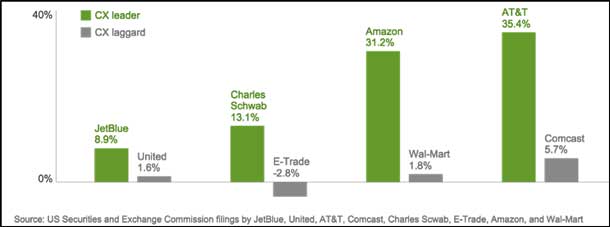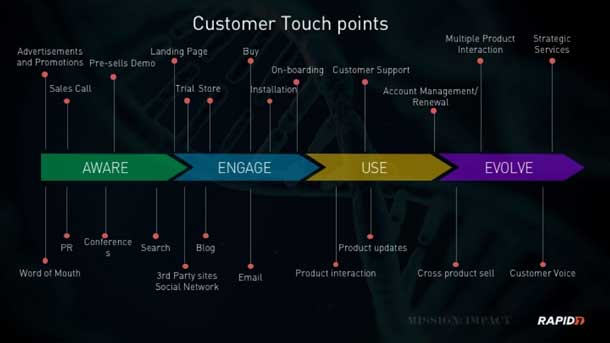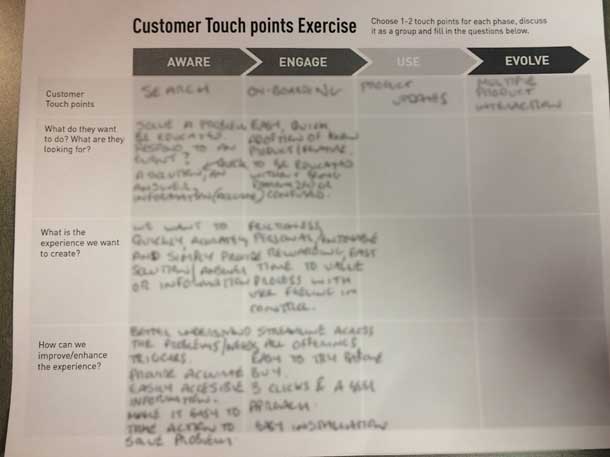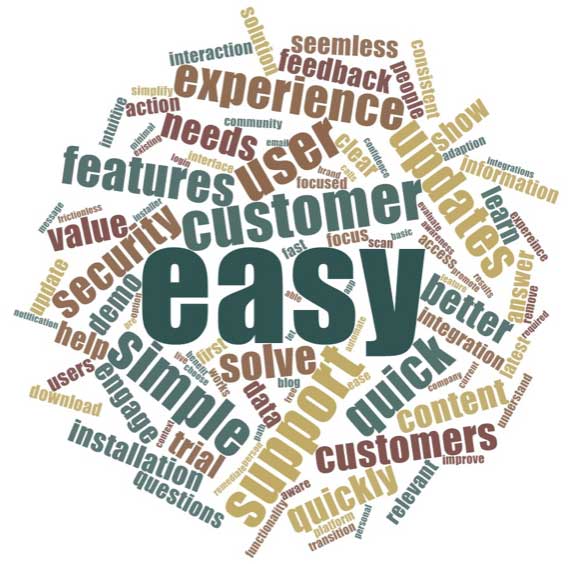It is no longer sufficient for organizations to focus solely on the “user experience” in order to deliver first-in-class product and service experiences. To be industry leaders, we need to think holistically across our organizations, to capture and consider all customer touchpoints—the points of contact customers have with an organization such as a call or a website visit. As evangelists of the “experience,” we need to break organizational silos and think broadly from a customer experience (CX) perspective.
Many organizations collect Net Promoter Scores (NPS) to understand how their customers feel about their organization. However, these scores do not tell the story of their customers’ end-to-end journey. As customers move through that journey, organizations regularly fail to capture and internally communicate what customers want to do and what they are looking for or what experience the organization wants to create for customers and how to improve that experience.
The leap from UX to CX can be a huge mind shift for many organizations. This article spells out strategies and processes that provide a framework to assess the maturity of the CX within your own organization.
What is CX?
CX represents the interactions between an organization and their customers as they move through multiple touchpoints within the end-to-end customer journey or experience. This end-to-end experience starts when customers first become aware of an organization’s products and services and extends right through to when they become long-term customers. CX differs from UX as CX considers the customers entire end-to-end experience while UX focuses only on a customer’s experience with a product.
Forrester Research reports that organizations that put customers front and center by creating a great CX have increased their revenue and share price far more than companies that have not (see Figure1).
Deanna Laufer at Forrester suggests that more companies will make the required shift in their strategic thinking in 2016. “Leaders will tackle the challenge of making this shift; laggards will underestimate the magnitude and speed of change required and will instead push forward with uncoordinated digital efforts and flawed business priorities.”

UX professionals think about customers all the time. We build products and experiences that map to the needs of our customers—wherever they are—within their overall journey. CX, however, is not something that occurs naturally. It requires broad knowledge and a holistic understanding about the customers’ experience across multiple interactions. CX focuses on the whole experience as opposed to individual pieces within the whole.
Assessing CX Maturity Level
As UX professionals, we know the importance of benchmarking—to learn where we are now so that we can measure success and improvement in the future. It’s no different with CX; before you try to improve your organization’s CX, you need to know where you stand right now. At Rapid7, a security, data, and analytics company, we’ve designed and implemented a strategy to assess the CX maturity of our company. The effort was run by the UX and product strategy teams, whereby we started by identifying and mapping each customer touchpoint across all of our company’s products and services (see Figure 2). Following identification of touchpoints, we evaluated each one using the following framework, based on a concept developed by Christina Li, founder of Infinite Interactive.
- AWARE – Position the brand in the customer’s mind by achieving consistency and coherence across products and services to make our product experiences instantly recognizable.
- ENGAGE – Provide a frictionless first-time experience for each touchpoint to make the product or service inviting and to allow customers to see value quickly.
- USE – Create experiences to match customer needs; deep focus on personas.
- EVOLVE – Follow data-driven design to facilitate quick understanding of customers, which will drive product and service usage.

Conveniently, our organization’s 2016 global kick-off event in Boston coincided with the start of this effort. Following the pillars of the Aware, Engage, Use, Evolve framework, we took the opportunity to ask the team (in small groups of 4-5 people per group) to answer the following questions:
- What are some customer touchpoints?
- What do they (customers) want to do? What are customers looking for?
- What is the experience we want to create?
- How can we improve/enhance the experience?
Each of the 60-odd groups were given a piece of paper with the Aware, Engage, Use, Evolve framework noted across the top with the four questions listed down the side (see Figure 3). The groups had about 20 minutes to complete it.

At the conclusion of the exercise, we asked volunteers to go to the front of the room and present their group’s results, that is, their impression of our customers’ overall experience. This sparked great discussions around different touchpoints where we, as a group, felt we were doing well and also where there was room for improvement.
While the methodology described above worked for us, it’s certainly not the only way. Touchpoints within the experience, including customers’ expectations and emotions, can be captured as described here, or you can use other moderated and un-moderated methods. Results can also be visualized and tracked in a number of ways, including within a customer journey map.
We gathered all the customer touchpoints sheets and entered the data points into Excel, where they were further synthesized to reveal high-level themes. These themes provided more insight into where we as a company are doing well, where we need to do conduct further investigation, and where we most clearly need to improve. For instance, employees collectively reported that the most important thing the company can do to ensure customers have a positive experience is to make that experience “easy” (see Figure 4).

We also learned what employees believe is important to our customers. For example, for the questions “What do they want to do?” and “What are customers looking for?” employees shared the following responses:
- Aware – Customers want to gain awareness through dissemination of clear and targeted personal messaging about our products and services.
- Engage – Customers want to engage through free, easy-to-install and use trials and demos; quick and easy access to our products.
- Use – Customers are looking for us to continuously and seamlessly improve and update our products. Updates should be invisible, unobtrusive, and automatic.
- Evolve – Customers are looking for a simple, consistent, and focused experience with seamless integrations across our products. We must provide customers with the ability to give feedback and to know that their feedback is heard.
There were additional benefits as well. The exercise brought customers’ needs and wants to the forefront of employees’ minds. It also revealed that certain customer touchpoints are perceived by employees to be more important than others, which is helpful in determining future focus. And most of all, the importance of the end-to-end customer journey, and not just the little part any one employee experiences, becomes obvious.
Putting a Plan in Motion
Validation of the findings has started, and it is an ongoing process. Our approach has been to bring in customers to see if the information from employees and customers triangulates or converges. Do our perceptions of CX maturity match reality?
While this is a question we will continue to research over time, the effort has allowed us to a stake in the ground and gives us something to measure future CX success against. For us, it’s important to let employees know where we think we stand– what we’re measuring and how the assessment is changing based on additional feedback and analysis.
To that end, employees are being informed of the results of the exercise during a series of recent roadshows in different offices. Currently, we plan to repeat the exercise in 2018, giving us the ability to compare and contrast the results from the 2016 exercise and gauge how our organization’s CX maturity has changed.
Overall, the customer touchpoints exercise was a great first step to help us begin to assess the CX maturity of our organization. Are we where we want to be? Are employees aware of what customers want to do and the experience we want to create? Our employees concluded that the key to great CX is customer interactions with our company that are seamless and easy. As we speak with customers about their actual experiences, we’ll see if that is the case, and where we need to improve.
How Mature are You?
In 2016 and beyond, the end-to-end customer experience will become a vital differentiator. UX professionals, among others, will have to scale and integrate well into this new, critical role. The first step is to gauge your organization’s CX maturity. Does your organization as a whole know what customers want to do, what customers are looking for, what experience they want to create for customers, and how the organization can improve your customers’ experiences? Which parts of the end-to-end CX work well? Any which are painful and disjointed?
Resources can then be focused in the areas that need improvement, saving time and cost in the short term, and reaping the rewards of more satisfied customers in the long term. These are questions worth asking in your organization, because remember: the customer will be the ultimate judge.
If your company’s CX maturity level is high, putting the customer first may be relatively simple. But if your company’s CX maturity level is low, becoming a CX-focused organization may be slow and cumbersome process. Either way, it is vital to ensure the customer is front and center in the organization’s strategic thinking. Employee training and well thought-out personas can facilitate this endeavor




